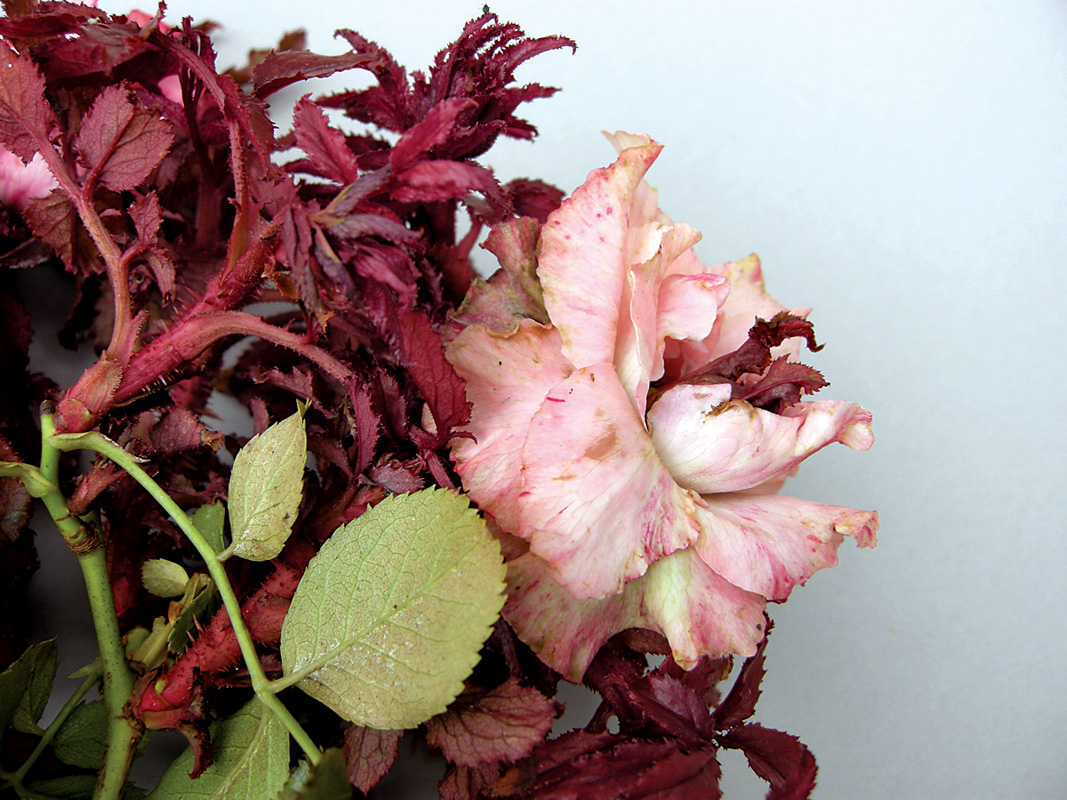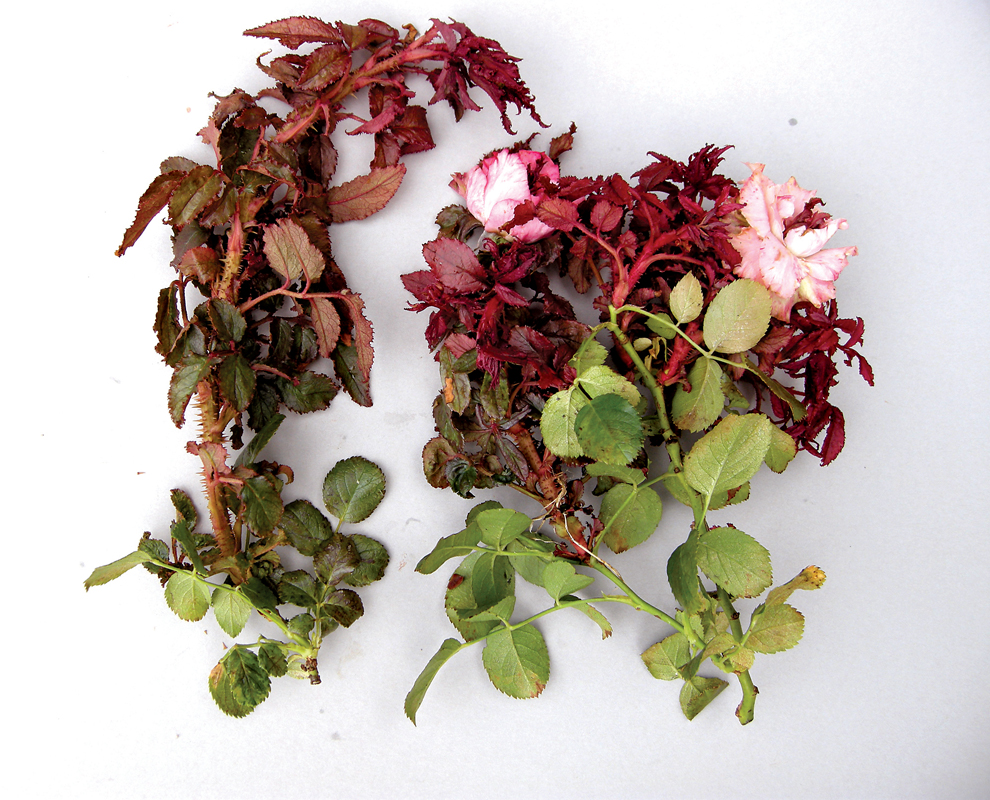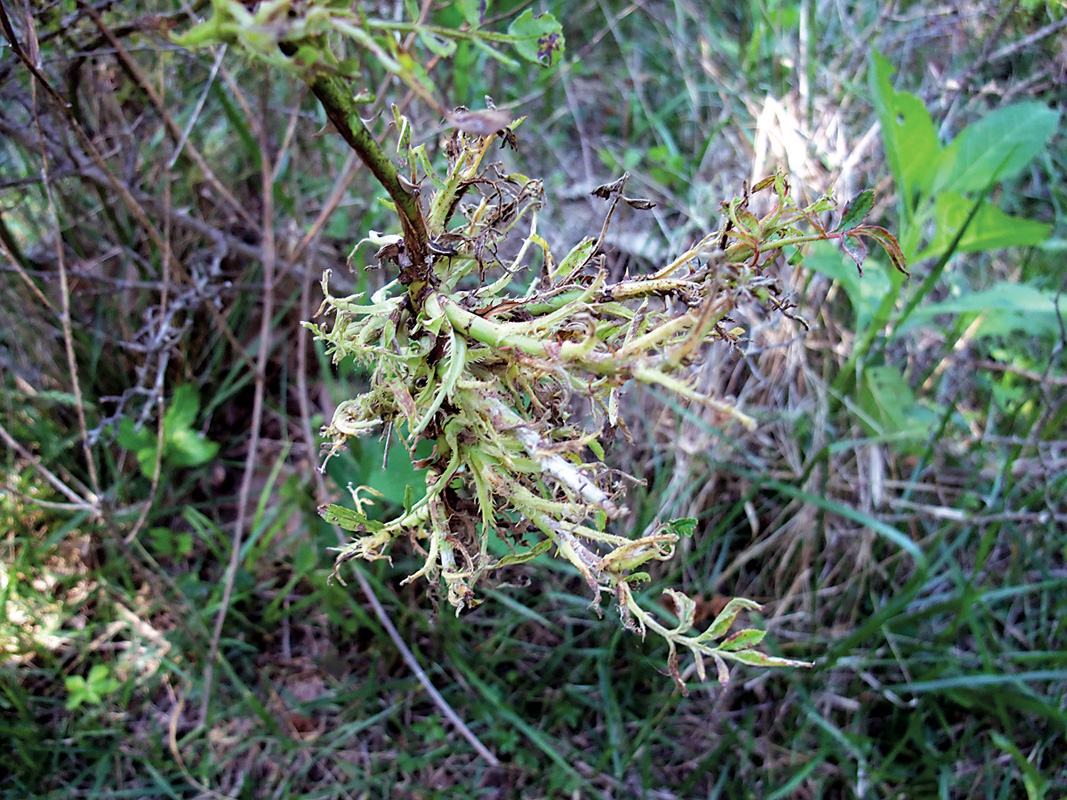Rose disease knocking out favorite flower
Friday, January 1, 1904
SIGNS OF ROSE ROSETTE DISEASEWondering if your Knock Out roses have Rose rosette disease? Barbara Wolff, horticulturist at Ooltewah Nursery and Landscaping Co., says to look for these signs:• Distorted foliage and flower petals on the end of the red stalk.• Together, stalk and foliage form a broom shape, which has given it the nickname "witch's broom."• A fat, red stalk shooting out of middle or side of the rose bush, often with excess thorns on affected stems.ONLINEFor more information on rose rosette disease, visit:• pubs.ext.vt.edu/450/450-620/450-620.html• www.conard-pyle.com/index.cfm/fuseaction/home.showpage/pageID/143/index.htm
Rosemary Wolff has been growing roses for more than 30 years, so she knew something was wrong when red, broom-like sprouts started popping up on her hybrid tea roses.
Her daughter Barbara, horticulturist at Ooltewah Nursery and Landscaping Co., quickly ID'd the problem -- rose rosette disease. She told her mom there's only one thing you can do when a plant is struck by the illness -- dig it up and get it away from the other roses.
But Rosemary is trying radical surgery first.
"One bush is one of the oldest I have in my yard. It's a beautiful bush, and I love it," she says. "There were two branches coming out of the bush at its base, so I cut off all of one side that I could but I didn't cut it all the way back to the ground. I don't think it has solved the problem because I have since noticed little sprouts coming out, so I'm just watching it."
Barbara, who says she noticed the disease in regional roses about three years ago, isn't hopeful. The aggressive disease is a mite-spread virus and "once you get the virus, you have it. There is no control," she says.
Rose rosette disease has been spreading through much of the wild rose population in the Midwestern, Southern and Eastern United States for years, according to research by Chuan Hong, a plant pathologist with Virginia Tech. Recently, it's been confirmed in cultivated roses -- Knock Out, Drift and Flower Carpet roses, to name a few popular types.
Disease characteristics include "witch's broom" growth, or clustering of small branches, as well as reddening, distorted, stunted and elongated leaves.
The elder Wolff says the disease was easily identifiable not only by its red growth but the proliferation of thorns on the affected stems.
"It is in Chattanooga," says horticulturist Craig Walker, known as the "plant doctor" at The Barn Nursery. "We recommend that you plant the shrubs far enough apart that the mite can't jump from one plant to another. If the mite is on a cane, cut the cane all the way down. If the mite comes back on several other canes, remove the entire shrub."
Walker says that, though the disease is in the area, only a couple of customers have brought in a diseased plant for him to examine. While some nurseries around the country have stopped selling roses because of the disease, the rose shrubs at The Barn Nursery are healthy, he says, and "we are still selling roses."
The disease, first documented in 1941, is traced to the multiflora rose, which came from Japan in 1866 as a common rootstock for ornamental roses. Unfortunately, it was found that multiflora roses are bad because a single plant can produce a million or more viable seeds per plant; over time, the roses have become known as invasive weeds with enormous disease problems. Today, new roses like Knock Out and Drift roses are grown on their own rootstock.
Star Roses and Plants by Conrad-Pyle, developers of Knock Out and Drift roses, are putting extensive research into the problem, according to company President Steve Hutton. They hope some of the native roses will provide disease-resistance answers.
"Some of the U.S. species with resistance to Rose rosette disease are Rose palustris, R. arkansana, R. setigera and perhaps a couple others," he says. "The disease can infect any modern rose such as hybrid teas. Seems like anything with Asian roses in its background is susceptible -- again, this is a theory, not yet proven."
Tim Holcomb at Holcomb Garden Center in Fort Oglethorpe, Ga., and Hixson has seen rose rosette disease, too, and says there are steps gardeners can take to lessen the chances of contracting the disease.
"You always want to spread your roses apart a little so air can circulate around them. It's better that they don't quite touch," he explains.
Good sanitation -- picking up dropped rose petals and foliage, washing work gloves after pruning -- can help prevent it and other plant problems, he says. Pruning is also crucial to keeping the problem away or under control.
"We recommend when people first see the diseased stem, to cut it out," says Holcomb. "Clean your pruners with alcohol so it doesn't spread the virus. Feed the roses with rose food with insecticide and that will help it recover and control the mites."
However, rose rosette is a very aggressive disease, he says, and if the plant continues to decline after pruning, you should remove the diseased plant to prevent spreading rose rosette.
"It doesn't linger in the soil, so you can pull out the diseased bush and replant a new one," he says. "Roses are a very inexpensive shrub that gives you maximum color, so their benefits still outweigh the negatives."
Prevention is the best strategy, according to plant pathologist Hong. Buy healthy plant material, he advises, and fertilize and water plants as needed to keep their immunity strong.
"Regular pruning is an important part of rose maintenance, thus it's advisable that people periodically sterilize their pruners and other tools to reduce local disease spreading," he says.
"People including myself love roses, and roses will continue to be an important component in home yards. A way forward is for rose societies, the public and science community to work together to find more effective control options for this growing disease problem."
If you want to avoid the problem totally, there are many other flowering shrubs that will provide months of color in place of roses, including Encore azaleas, butterfly bush, abelia, spiraea japonica, hydrangea paniculata, rose of sharon and tropical oleander.
Staff writer Karen Nazor Hill and McClatchy-Tribune News Service contributed to this story.


